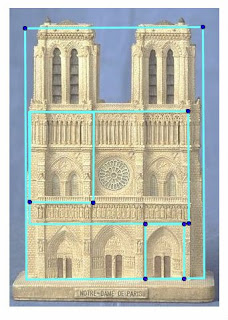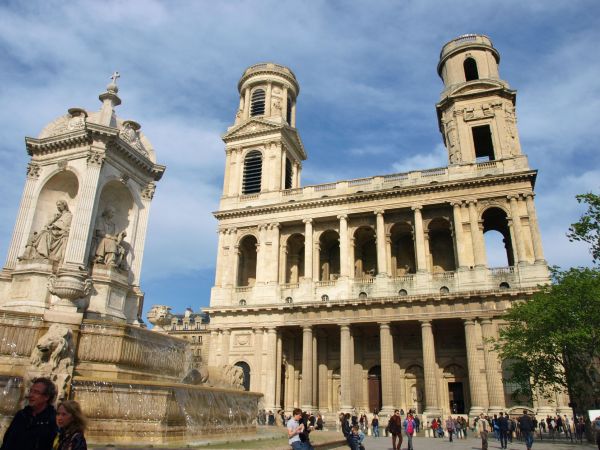
Iglesia de Saint Sulpice.
¿Eres uno de los que aún no has leído “El Código Da Vinci“?
Puede ser, es una opción pero, según deduzco de las lecturas de las personas más cercanas a mí, son muy pocos los que si no lo han leído, lo han visto en el cine.
Si tu respuesta ha sido negativa, es posible que este post no lo entiendas del todo. Si tu caso es el contrario, lo has leído, incluso lo has releído o visto en la pantalla gigante, entonces sabrás de lo que vamos a hablar en las próximas líneas.

Iglesia de Saint Sulpice.
Es bueno saber esto, porque Dan Brown como escritor, a la hora de describir lugares o hechos históricos deja mucho que desear con la exactitud de los mismos.
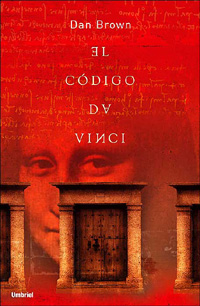 No quiero entrar en si su calidad literaria es buena, mala o regular, sino que, al plasmar sus relatos en el papel adapta hechos y espacios de tipo histórico-geográfico propias del escritor de ficción y no de un profesor de historia. Es lo lógico en un escritor de novelas, por otra parte, no estoy descubriendo nada que ya no se conozca..
No quiero entrar en si su calidad literaria es buena, mala o regular, sino que, al plasmar sus relatos en el papel adapta hechos y espacios de tipo histórico-geográfico propias del escritor de ficción y no de un profesor de historia. Es lo lógico en un escritor de novelas, por otra parte, no estoy descubriendo nada que ya no se conozca..
En cuanto a su calidad literaria, me parece que Dan Brown tiene buenas ideas argumentales, pero sus recursos lingüísticos son muy pobres, especialmente a la hora de construir los diálogos de la novela. Pero esto es algo de mi percepción personal y que es fácil de rebatir por lo millones de lectores que ha tenido su obra. Utiliza los hechos reales a su antojo, si la verdad histórica no coincide con sus necesidades narrativas, las acomoda sin rubor. Es algo que no se le puede echar en cara, para eso es escritor imaginativo, sino que hay que, simplemente, puntualizarlo para poder entender lo que después vamos a describir.
Lo mismo ocurre con descripciones de lugares que llegan a sonrojar al menos entendido por su laxitud y poco rigor, pero repito, es un libro de ficción no histórico. Se disfruta de su literatura si utilizas “El Código” como modo de evadirte de la realidad. Si buscas una referencia literaria a la que asir tus conocimientos y que te sirva de refencia, olvídate de su obra.
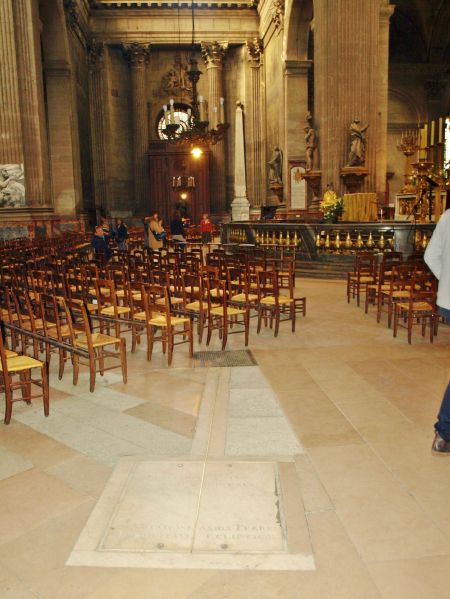
Iglesia de Saint Sulpice.
Dicho lo cual, retomemos el hilo conductor que da pie al título de este post y vayamos a centrarnos en el capítulo 22 de “El Código Da Vinci”.
Recordamos que, Silas, el religioso albino del Opus Dei, a las órdenes del Obispo Aringarosa, va buscando el secreto del Santo Grial envíado y dirigido por su desconocido “Maestro”. Tras matar, no sin antes arrebatarle el dato importante, a los cuatro “sénéchaux” del Priorato de Sión, conocedores de la clave del Santo Grial, se dirige a la Iglesia de Saint Sulpice a una hora intempestiva, la una de la mañana.
Allí, debido a las influencias del Obispo Aringarosa, consigue adentrarse en la Iglesia tras una breve conversación con Sor Endrine, su custodia.
Estamos en el momento en que Silas busca una línea en suelo y un obelisco, en cuya base, bajo el frío mármol, debe encontrarse la clave que descubra la situación exacta del Santo Grial.

Inicio del Gnomón.
Aquí nos paramos, porque vamos llegando, poco a poco, al lugar donde Dan Brown, me imagino que por una adecuación de un lugar a su historia ficticia, utiliza un dispositivo astrológico (que ahora describiremos más concienzudamente) como si fuera una supuesta “Línea Rosa”, el lugar por donde, según él, pasaría el meridiano cero, el Meridiano de París, el lugar desde donde se medía la distancia entre dos puntos hacia el este o el oeste antes de que, en 1884, apareciera un barrio en las afueras de Londres llamado Greenwich.

Gnomón astronómico en el suelo de Inicio de Saint Sulpice.
Es verdad que el Meridiano de París exitió. Es verdad que este meridiano está documentado sobre las piedras de las calles de París con unas placas redondas, las célebres “ARAGO”, que indican el camino exacto norte-sur por donde discurre el meridiano. Y es verdad también que dicho meridiano pasa a más de 100 metros de la Iglesia de Saint Sulpice, en el Barrio Latino, 6º Arrondissement de París. Pero…
… Dan Brown miente. El Código Da Vinci miente. Y la línea que cruza el altar de la iglesia no es la Línea Rosa. Y la Línea Rosa no existió. Y el Obelisco tampoco forma parte del meridiano de París.

Obelisco del Gnomón.
Entonces, ¿qué artilugio es ese al que Dan Brown hace referencia? La respuesta es evidente: es un gnomón astrológicoy lo vamos a describir continuación.
El gnomón astronómico de Saint Sulpice fue una petición que hizo el Padre Jean Baptiste Langet a Henry Sully, un relojero y astrónomo británico. Sully lo fabricó en granito de la región de París y fue colocado y terminado en 1727. El gnomón es un calendario solar que sirve para determinar la fecha en la que se producen los solsticios y los equinoccios durante el año.

Obelisco del Gnomón.
El elemento principal del gnomón, y, sin él, no puede funcionar es el Sol. Aquí es la madre naturaleza la que manda. Para los demás elementos, es la mano del hombre la que construye.
El segundo elemento del gnomón de Saint Sulpice es una vidriera en la pared central del ala derecha del crucero. Dicha vidriera está dividida en pequeños cristales. Todos son transparentes y dejan pasar la luz del Sol, a excepción de uno, que es opaco y será el encargado de proyectar la sombra sobre el suelo. Este cristal está situado una distancia de 24 metros y 54 centímetros del mismo.
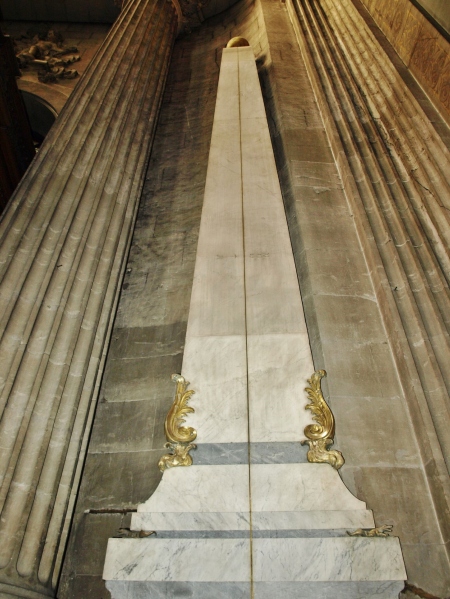
Obelisco del Gnomón.
Conforme va pasando el año y las estaciones, el Sol cambia de posición con respecto a la Tierra. En invierno los rayos son más inclinados, en verano son más verticales. Pues bien, tenemos el sol brillando y una sombra proyectada sobre el suelo. En el solsticio de verano (21 de junio de cada año) es cuando el Sol está en su línea más cercana a la vertical. Por tanto donde proyecte las sombra este día se marcará como “Solsticio de Verano”. En Saint Sulpice hay una placa de mármol sobre el suelo que lo marca. Esta placa está situada a 11 metros 34 centímetros de la pared donde se encuentra el cristal opaco.
De esta marca en el suelo que, como dijimos está en el ala derecha del trasepto de la iglesia, nace un línea de cobre incrustada en el suelo en dirección al otro ala del trasepto en un ángulo aproximado de 60 grados. Dicha línea atraviesa el altar que está situado en medio del trasepto bajo la hermosa cúpula de la iglesia. Conforme van transcurriendo los días, la sombra se va desplazando por la línea hasta llegar junto al altar donde hay una plancha redonda de cobre rodeada por un semicírculo del mismo elemento. Este punto marcará los Equinoccios, el momento en el que el día dura exactamente igual que la noche, lo que ocurre los días 23 de Septiembre y 20 de Marzo. Desde la placa de mármol hasta este punto hay 16 metros y 32 centímetros.

Cristalera del Gnomón.
La línea continua progresando, atraviesa el altar y llega hasta la pared central del ala izquierda del transepto. Ha recorrido 23 metros y 97 centímetros. Allí tropieza con un obelisco que tiene 10 metros y 72 centímetros de altura. El obelisco termina en una bola redonda de bronce. Cuando el Sol proyecte la sombra sobre dicha bola, habremos alcanzado el Solsticio de Invierno, justo el día del año en el que la noche es mayor durante todo el año. Ocurre todos los días 21 de Diciembre.
En pocas palabras este es el funcionamiento del gnomón de Saint Sulpice, la segunda iglesia en importancia de París tras la Catedral de Notre Dame.
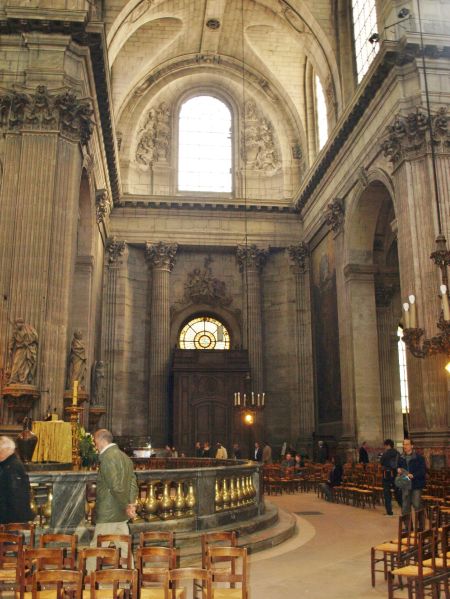
Cristalera del Gnomón.
Espero que, cuando releamos “El Código Da Vinci” y lleguemos al capítulo 22, podamos decir con conocimiento de causa que el elemento que nos presenta Dan Brown es un gnomón astronómico al que él, como autor de ficción, le añade cierto aire de novela de intrigas.

St Sulpice. El gnomon astrologico famoso por el Codigo da Vinci
